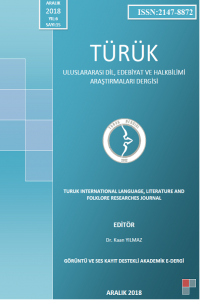KIZIL DAMGA ve CENGİZ HAN’A KÜSEN BULUT’TA YASAK ÇOCUK
Bu çalışmada iki farklı kültüre ait olan Kızıl Damga ve Cengiz Han’a Küsen Bulut romanlarındaki “yasak çocuk” konusu ele alınacaktır. Eserlerde vakanın çıkış noktasını birer “günah/suç delili” olan yasak çocuklar oluşturur. Yasak çocuk Kızıl Damga’da, din ve toplum kurallarının çiğnendiği yasak aşkın sonucu doğan günah/suç meyvesidir. Cengiz Han’a Küsen Bulut’ta aşk yasak değildir fakat doğan çocuk siyasî otoritenin koyduğu yasağın çiğnenmesi sonucu yasak olmuştur. Evrensel bir duygu olan aşk karşısında insanların davranışları da benzerlik göstermektedir. Her iki eserde de yasağı çiğnemek söz konusudur. Yasak çiğnendiğinde alınacak ceza kaçınılmazdır. Suçun delili çocuk olduğundan ilk bilinen suçlu anne/kadındır. Böyle bir suç tek başına işlenemeyeceğinden günah/suç ortakları merak edilir. Kadınlar çocuklarıyla beraber hem topluma ibret olması hem de günah/suç ortaklarının ortaya çıkması için toplum karşısında teşhir edilirler.
Anahtar Kelimeler:
Hawthorne, Aytmatov, yasak çocuk, teşhir
FORBIDDEN CHILD IN THE NOVELS THE SCARLET LETTER AND CENGİZ HAN’A KÜSEN BULUT
In this article, the topic “forbidden child” in the novels The Scarlet Letter and Cengiz Han’a Kusen Bulut both of which belong to two different cultures will be handled. Forbidden child, who are considered as “proof of sin/crime”, constitude the starting point for the events in each of the two novels. Forbidden child born as a results of forbidden love where the rules of religion and society are violated are the fruits of sin/crime in The Scarlet Letter. Love is not forbidden in Cengiz Han’a Kusen Bulut. However, the child born in this novel have become forbidden as the laws imposed by the political authorities are violated. People’s behaviors show similarity towards love, which is a universal feeling. The subject matter in both of the two novels is violation of bans. Punishment is inevitable when bans are violated. As the proof of the crime is the child, mother/woman is the first one to put the blame on. Since such a crime cannot be committed alone, partners of the sin/crime are wondered. Women together with their children are exhibited to give a lesson to the society as well as to make the partners of such sin/crime reveal themselves.
Keywords:
Hawthorne, Aytmatov, forbidden child, exhibition,
- Başlangıç: 2013
- Yayıncı: Yasin ŞERİFOĞLU
Sayıdaki Diğer Makaleler
BALIKESİRLE İLGİLİ BAZI KAYNAKLARDA CÂMİÜ’D-DÜVEL’İN YANLIŞ VE DOĞRU KULLANIMI
TATAR DİLİ ŞİVELERİNDEKİ BİLEŞİK GEÇMİŞ ZAMAN BİÇİMLERİ
AYDIN VE YÖRESİ AĞIZLARINDA KULLANILAN ŞİMDİKİ ZAMAN ŞEKİLLERİ
KIZIL DAMGA ve CENGİZ HAN’A KÜSEN BULUT’TA YASAK ÇOCUK
SÜRGÜN MEKTUPLARINDAKİ ZİYA GÖKALP
XVI. YÜZYILDA BİR ŞARİH MUSTAFA BİN MUHAMMED ve Şerh-i Kelimat-ı Çehar Yar-ı Güzini.
KÜLTÜRBİLİM ALANINDA YAŞANAN KÜLTÜREL DÖNÜŞÜMLERİN KÜLTÜR ODAKLI ÇEVİRİ KURAMLARINA ETKİSİ
ÇUVAŞÇADA VE BAZI TÜRK ŞİVELERİNDE “ARDIÇ” KELİMESİNİN MİTOLOJİK ANLAMI VE ETİMOLOJİSİ
TÜRKİYEDEKİ KAZAN-TATAR TÜRKÇESİ ÇALIŞMALARI ÜZERİNE AÇIKLAMALI BİR BİBLİYOGRAFYA DENEMESİ
